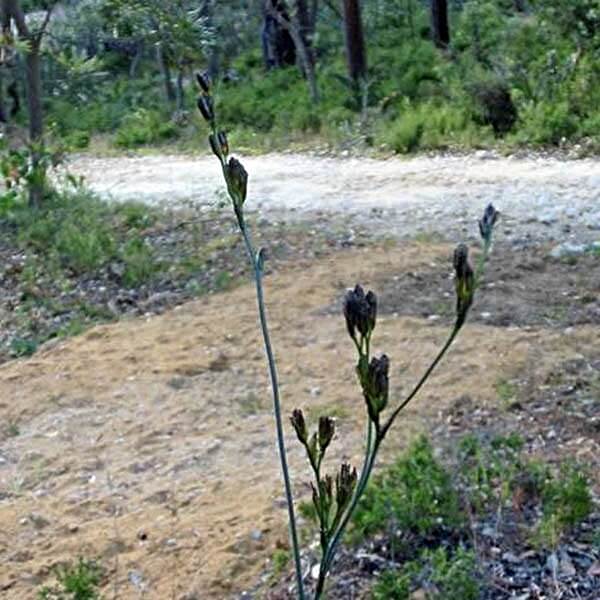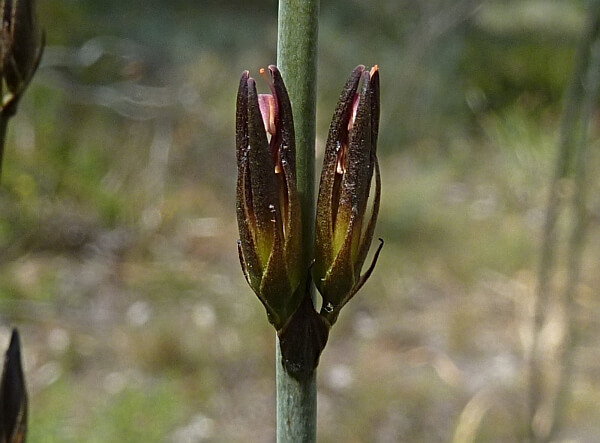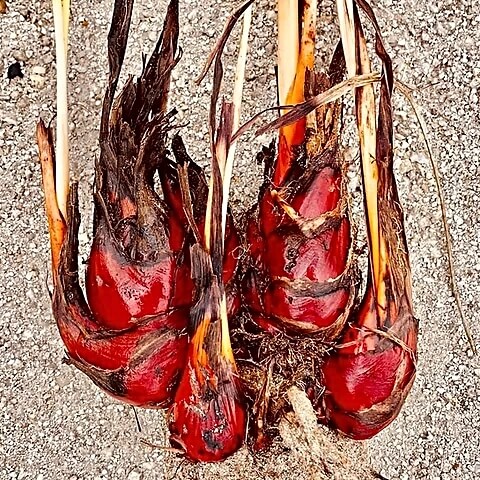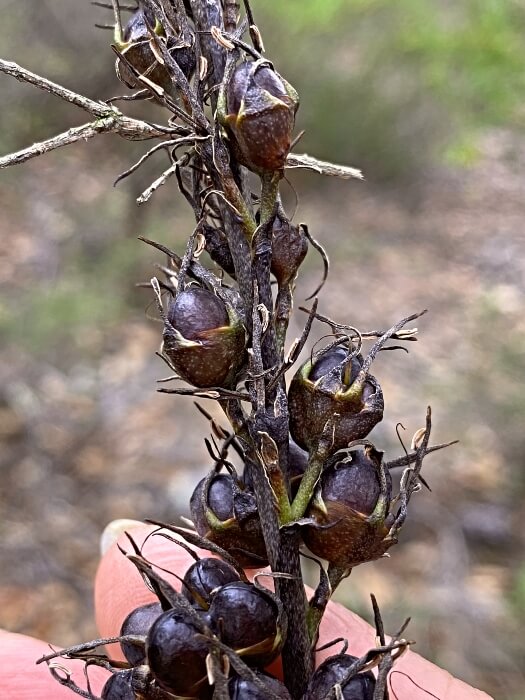Bloodroot earned its name from the colour liquid that leaks when the root of the bulb is cut. What’s amazing is that the chemicals in bloodroot that create the red to orange colour are unique to this plant. You don’t find this chemical anywhere else in the plant kingdom.
In this guide, I will share how to grow bloodroot, what it needs in terms of care including pests and diseases to look out for and how to treat them organically.
More...

Source: Australian Seed
Family: | Haemodoraceae |
|---|---|
Genus: | Haemodorum |
Species: | H. spicatum |
Common Names: | Bloodroot, Bohn, Meen, Mardja, Menang |
Origin: | Australian native |
Location: | Outdoor |
Type: | Bulb vegetable |
Growth: | Up to 2 metres tall and 0.5 metres wide |
Sun requirements: | Full sun, part shade |
Foliage Colour: | Green |
Flower Colour: | Yellow, red, purple, black, brown |
Flowering: | Spring and summer |
Edible Parts: | Roots |
Maintenance level: | Easy |
Poisonous for pets: | Yes |
Introduction to Bloodroot Plants
Bloodroot is known by many names - Bohn, Meen, Mardja, and Menang. This Australian native has played an important role in the lives of the Aboriginal people. The bulb vegetable has a long history with the Noongar people in Western Australia, and it was used for food and medical purposes.
Haemodorum spicatum is related to kangaroo paw and lives happily on the south and west coast of Western Australia. Bloodroot sometimes grows on its own, or otherwise in small clumps.
Haemodorum spicatum Plant Features
The roots are the edible part. Eating them raw requires some bravery because they are very spicy, to the point where your lips can go numb. The alternative is to bake or roast the roots, or dry them to create spice.
The colour of the bloodroot vegetable is truly unique and is why the roots were used to create a red dye. Haemodorum spicatum can grow up to 2 metres tall. The leaves are green and strappy and they turn black as the plant ages.
Bloodroot Flowers
During the flowering season from October to January, the bloodroot sprouts a spike with a flower on the tip, usually a purple to black colour but this can vary.
The pollination process of bloodroot is fascinating. Bloodroot flowers are pollinated by native bees, but these are no ordinary bees. They are so strong that they dive into bloodroot flowers, pushing open the petals, to collect the pollen and nectar.
How to Grow Bloodroot Plants
Haemodorum spicatum likes to grow in full sun but part shade is also fine. The best kind of soil to grow bloodroot plants would be a light, sandy, well drained soil so it doesn’t become waterlogged. Since bloodroot is a drought tolerant plant, it will also grow in poor sandy soil or even sandy clay soil.

Source: Friends of Queens Park Bushland
How to Propagate Bloodroot from Seeds
The best time to sow seed to plant bloodroot would be spring or autumn. Hot or cold extremes are not helpful and the best temperature range for germination is between 18 to 22°C.
Select a porous seed raising mixture and sow the bloodroot seeds on the surface. When the mixture is watered the seeds will then find their way into the pores. Lightly sprinkle some seed raising mix over the seeds but don’t bury them.
Gently mist the seeds and then put them somewhere warm and shaded. The mix should stay warm and moist. Don’t let it dry out or become waterlogged. It takes about 21 days for germination if the conditions are right. In some cases the process can take up to 90 days so some patience is required.


Get Your Free Guide:
Master Growing Australian Natives eBook
A Must Have Complete Guide for Every Australian Garden
Get Your Free Guide:
Master Growing Australian Natives eBook
A Must Have Complete Guide for Every Australian Garden
Tips for Bloodroot Care
Haemodorum spicatum is considered a water wise plant. Bloodroot plants doesn’t really need fertiliser. To optimise growth for the plant, apply organic compost and a slow-release fertiliser after harvesting. Pruning isn’t needed for Haemodorum spicatum.
Bloodroot Bush Tucker Guide
The red roots of Haemodorum spicatum have been compared to pepper or chilli in taste. I love curries so I often use bloodroot as a seasoning ingredient. It also adds a lovely colour to whatever you are cooking.
You need very little to get a whole lot of flavour. Think of hot and spicy pizza toppings or to add some zing to a salad.

Source: Living Green and Feeling Seedy
Harvesting Bloodroot
The bloodroot bulbs can be harvested in August and September. You just dig them up and remove the root from the leafy parts that grow above the ground.
Common Bloodroot Plants Pests and Diseases
Slugs and snails
Keeping slugs and snails away from your bloodroot plant is fairly simple and you can use ingredients from your kitchen. Create a protective layer around your plant with a thick lining of bran or oats. When the slugs and snails eat it, they swell up. Layering of egg shells and coffee grounds are also effective.
Caterpillars
A vinegar and water spray works wonders to kill off and keep away many garden pests. These include caterpillars. Mix 2 tablespoons of vinegar to 4 litres of water and then spray wherever pests are spotted.
Aphids
Aphids in the garden can be tackled with good old soap and water. Mix up a couple of tablespoons of dishwashing liquid in water and create a spray for infestations. Essential oils are also great.
Good options are peppermint, clove, rosemary, and thyme. Add about 5 drops of oil and mix with water to create a spray. Cover any affected plants well to get rid of the adults and also the larvae and eggs.
Read our comprehensive guide to dealing with aphids for more details.
Leaf miners
For plant leaves that are under attack from leaf miners, the best solution is to prune off the necessary sections and dispose of them. In the case of minor leaf damage, gently squeeze the leaves to kill the pests without having to prune off the leaves.
Rust
Sulphur works wonders to help treat and prevent the rust fungus. It needs to be applied weekly. Neem oil is another superpower organic option, and some gardeners say that baking soda combined with neem oil is the ultimate hit for rust fungus.
Frequently Asked Questions About Bloodroot

Source: iNaturalist Australia
Can I grow bloodroot in a pot?
Yes you can grow bloodroot in a pot. You’ll need a medium to large sized pot that has drainage holes. Fill it with a well-draining sand potting mix.
What are the Aboriginal uses of bloodroot?
The roots provided food and were either eaten raw or roasted. Bloodroot was also used to treat dysentery, lung congestion, mouth sores, toothache, and arthritis.
How is dye made from bloodroot?
The bloodroot is chopped up or crushed, then boiled in water to release the colour. This is the process to create red and brown dye. The purple dyes are created from the fruit of the bloodroot.
Who are the pollinators of the bloodroot flowers?
Pollination usually happens from bees, but birds and small mammals can also be part of the process.
What does the name Haemodorum spicatum mean?
Haemodorum comes from the Greek words haima, which means blood, and doron, which means gift. Spicatum comes from the Latin word spica, which means point or spiked flower.
What are the Aboriginal names for bloodroot?
Meen, Mardja, Menang, and Bohn.
Now You Know How to Grow Bloodroot Plants
Bloodroot is yet another awe inspiring Australian native that really packs a punch. From a modern medicine standpoint, it’s being researched for antibacterial and tumour fighting qualities.
Haemodorum spicatum continues to wow us as it first did among indigenous Australians who used it to treat snake bites and to create fire sticks. It’s the kind of plant that reminds us of the wonders and provision of nature.
Published on December 6, 2023 by Lorri Hopkins
Last Updated on January 19, 2025




